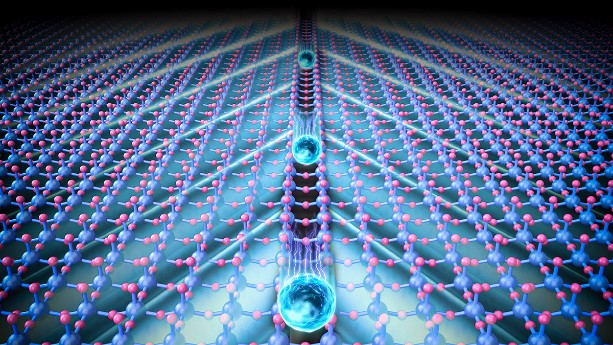
Share
Announcement/2023-11-20
The research team observed inverse Cherenkov radiation from phonon polarized excitons in the natural molybdenum oxide type I hyperbolic band. It was found that the distribution of the inverse Cherenkov radiation can be asymmetrically reshaped by changing

The importance of Cherenkov radiation for on-chip light sources is that it provides a viable path to realize nanosources with ultra-wide frequency coverage that can be widely used in micro- and nano-electronic devices, opto-electronic devices, and even opto-electronic integrated circuits. Cherenkov radiation is electromagnetic radiation produced when charged particles move faster than the speed of light in a medium. Among them, reverse Cherenkov radiation can effectively separate the radiated light from the fast-moving charged particles, thus improving the signal-to-noise ratio and sensitivity of the light source. Therefore, inverse Cherenkov radiation plays an important role in the fields of bio-imaging, optical communication, spectroscopy and sensors. Theoretically, inverse Cherenkov radiation can be realized in negative refractive index left-handed superstructured materials or natural crystals with negative group velocity dispersion. However, it is still challenging to realize inverse Cherenkov radiation in the optical frequency band due to the large loss in conventional artificial structures.
In recent years, Qing Dai's group discovered low-loss hyperbolic phonon polarization excitations in birefringent crystals such as van der Waals materials like hexagonal boron nitride and molybdenum oxide (Nat. Mater., 2021, 20, 43-48; Science, 2023, 379, 558-561). This hyperbolic phonon polarized exciton has negative group velocity dispersion in the mid-infrared range, which can substantially slow down the velocity of light within the medium, contributing to the lowering of the velocity threshold of the moving charged particles required for the excitation of the inverse Cherenkov radiation and providing a solution for realizing the inverse Cherenkov radiation in the optical frequency band. In addition, the research team has established a comprehensive set of theoretical models and experimental characterization methods for electronically excited polarized excitons in the related work on hyperbolic phonon polarized excitons (Nat. Nanotechnol., 2023, https://doi.org/10.1038/s41565-023-01324-3).
On the basis of the previous work, the research team observed the inverse Cherenkov radiation of phonon-polarized excitons in the natural molybdenum oxide type I hyperbolic band. It is found that the distribution of the inverse Cherenkov radiation can be asymmetrically reshaped by changing the motion direction of the charged particles. In addition, by constructing molybdenum oxide and hexagonal boron nitride van der Waals heterojunctions via atom fabrication techniques, the radiation angle and quality factor of the inverse Cherenkov radiation can be further improved. Therefore, this study is of great significance in the application of on-chip light sources in optoelectronic integrated circuits and provides a new idea to solve the difficult problem of efficient excitation of inverse Cherenkov radiation in the optical frequency band.
The research results were published in the journal Nature Communications under the title Mid-infrared analogue polaritonic reversed Cherenkov radiation in natural anisotropic crystals. Researchers Qing Dai and Xiaoxia Yang of the National Center for Nanoscience (NCNS) are the co-corresponding authors of the article, and Special Research Associate Xiangdong Guo of the NCNS and Chenchen Wu, a PhD student of the class of 2018, are the co-first authors. The above research work was supported by the National Key Research and Development Program of China (NKRDP) Nano Frontier Key Special Project and the National Natural Science Foundation of China (NSFC).
Original link: https://www.nature.com/articles/s41467-023-37923-w